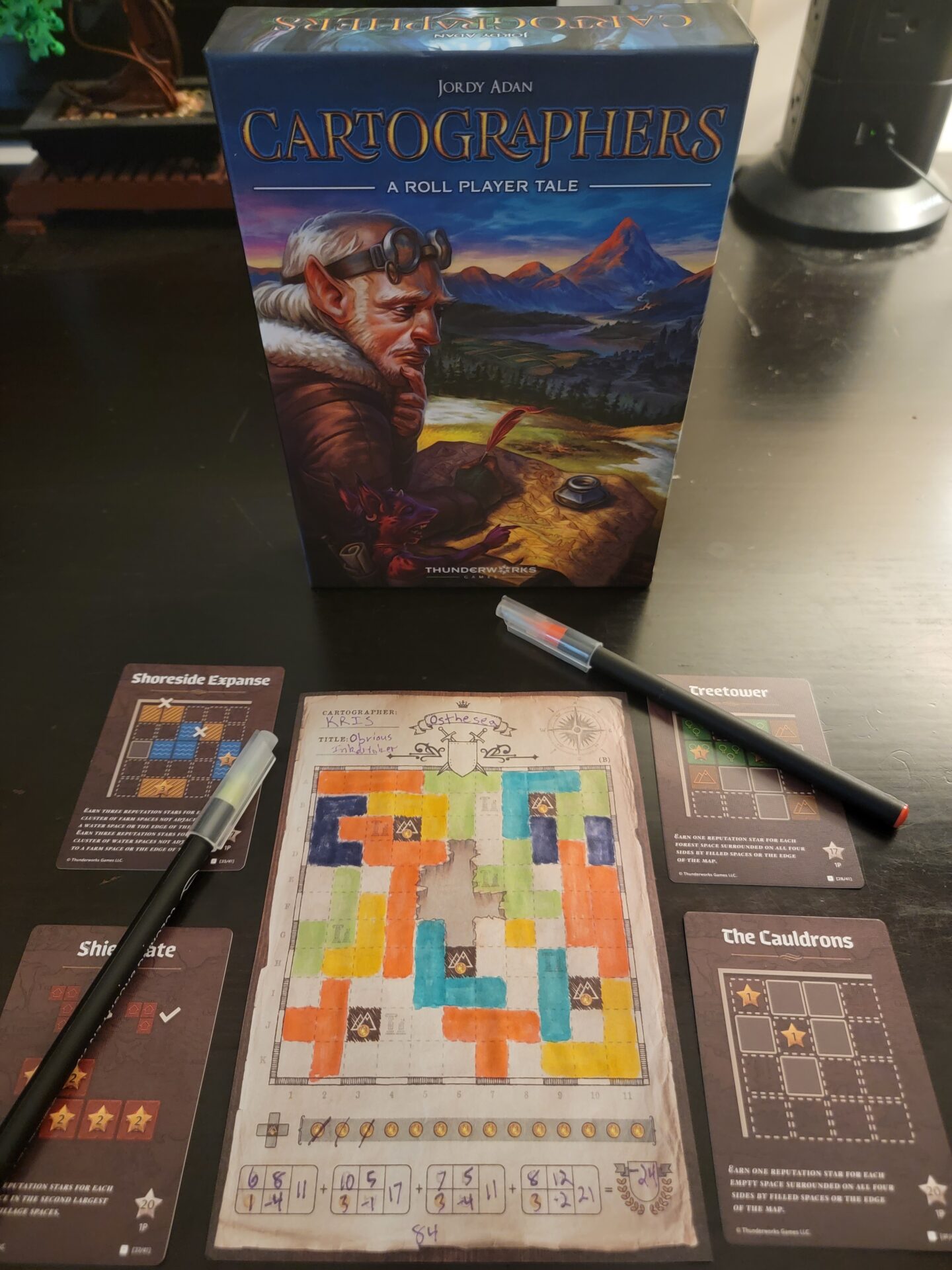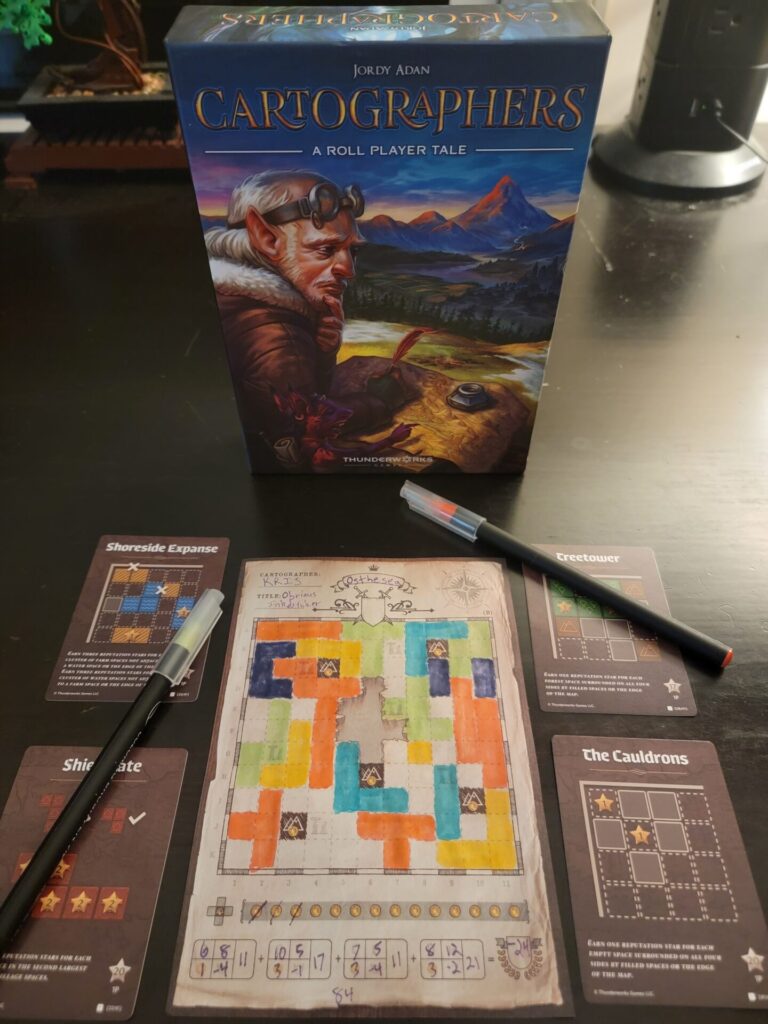
Name: Cartographers
Year of Release: 2019
Player Count: 1 – 100
Playing Time: 30 – 45 Minutes
Designer: Jordy Adan
Publisher: Thunderworks Games
Primary Mechanisms: Flip and Write, Grid Coverage, Simultaneous Action Selection, Solo
Weight (According to BGG.com): 1.88
Overview
In most all corners of popular culture, trends ebb and flow. Some thing becomes the thing in the zeitgeist, and a swarm of like-minded thing takes off. Eventually, these fade from the limelight and some other hot thing takes its place. This is not to say that these products, or people, or whatever it is, are no longer good, or valuable, but just that the popular opinion has moved on to yet something else to fawn over, and eventually, to chew up and spit out before rinsing and repeating, ad nauseum.
If you’re a follower of modern board games, you’ll know that this niche market is no different. Lately, the “roll-and-write” (or “flip-and-write” or “x-and-write” or…) genre seems to be the go-to style for new games. Even tried-and-true IP’s are creating offshoot versions of their games, adapting them to this style.
Call it the hipster in me, but I’ve thumbed my nose at these style of games for quite a while now. Hopefully, I’m not acting this way because they are popular (though anyone who knew me in college and heard me talk about how horrible “radio music” was can probably thoroughly believe this is my motive) but more so, the few that I tried just weren’t fun.
These experiences flashed in my head every time I saw some users on Mastodon post about how much fun they were having with Cartographers. My mind kept yelling at me that there is no way it is fun, you never have fun with these games, but something about it just kept intriguing me. Eventually, I pulled the trigger and ordered the game. Did it end up breaking the mold of the other (few) “x-and-write” games I’d played, or did it fall flat as heavily as all those others I had tried? Read on to find out!
Rulebook & Components
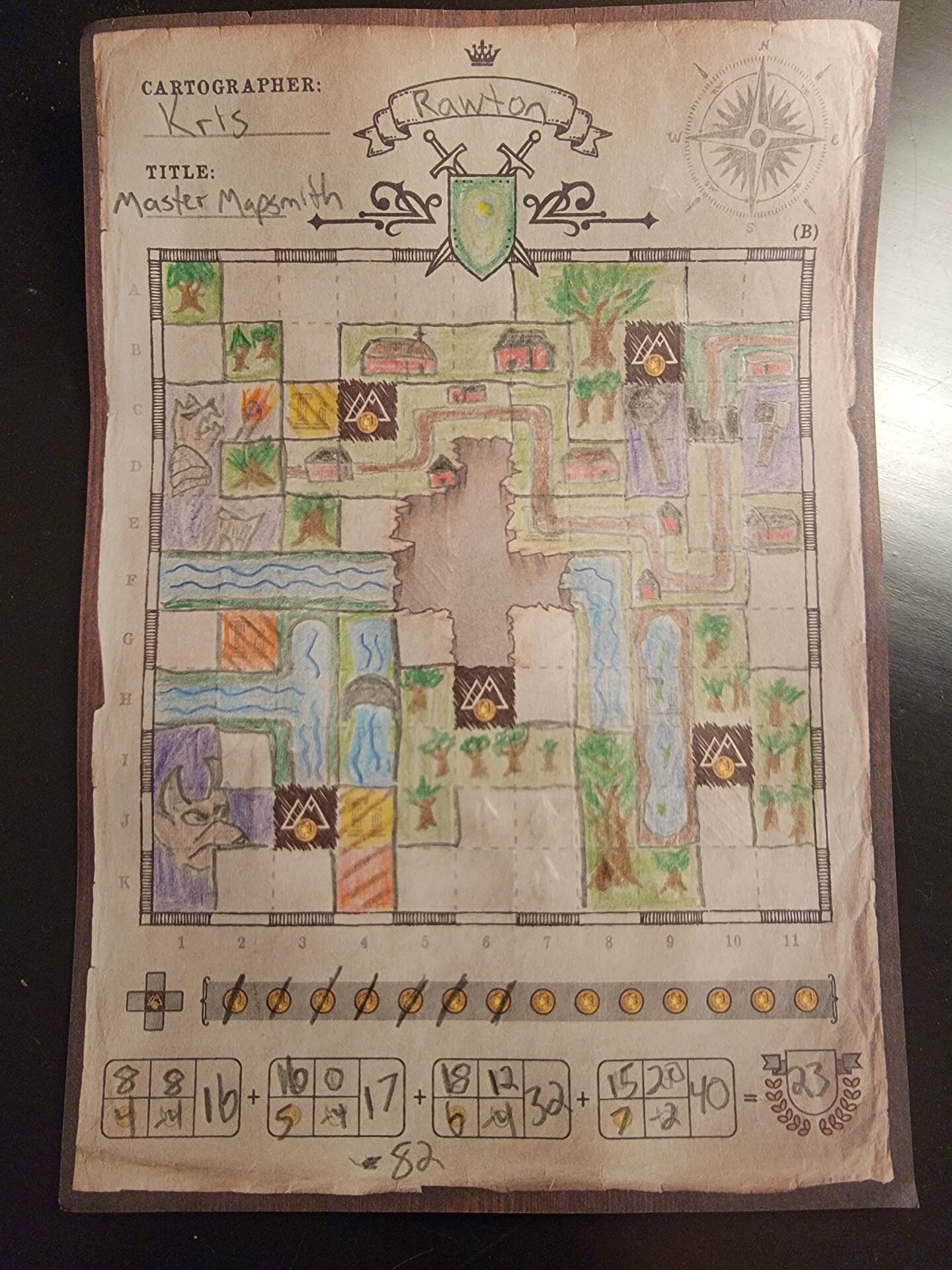
I typically go for games with a lot of components, big boards, individual player mats, and really everything and the kitchen sink, but lately, I’ve been gravitating to games with a smaller footprint that I can play on the bed or my smaller computer desk in our bedroom. Cartographers nails this requirement as the components are few and take up almost no space. It is basically a (small) deck of cards, a pad and… well, that’s it! The cards come in a few different types, so they don’t all go into the same deck but if you have room for five to six different stacks, you’re good to go. The artwork on the Explore Cards is fantastic, giving off the perfect fantasy vibe to the different environments they are showcasing. The Map Pad is basically a large grid of squares but even it has some nice, thematic touches, allowing players to name the land they are mapping as well as give themselves a title. There is even a blank shield where the player can draw their own coat of arms.
The rulebook gives players all the information to need, though honestly, with a weight of under 2 at BoardGameGeek.com, it’d be pretty hard to not make a decent rulebook. I do think it is a little odd that on pages 10 and 11, the rulebook presents all of the different scoring cards but just re-prints the exact same text from the card with no added explanation. I don’t want to paint the picture that the Scoring Cards are at all difficult to understand, but it’s strange to me to choose to devote two pages to these cards without actually clarifying any questions one might have about the scoring conditions themselves.
Setup and Gameplay
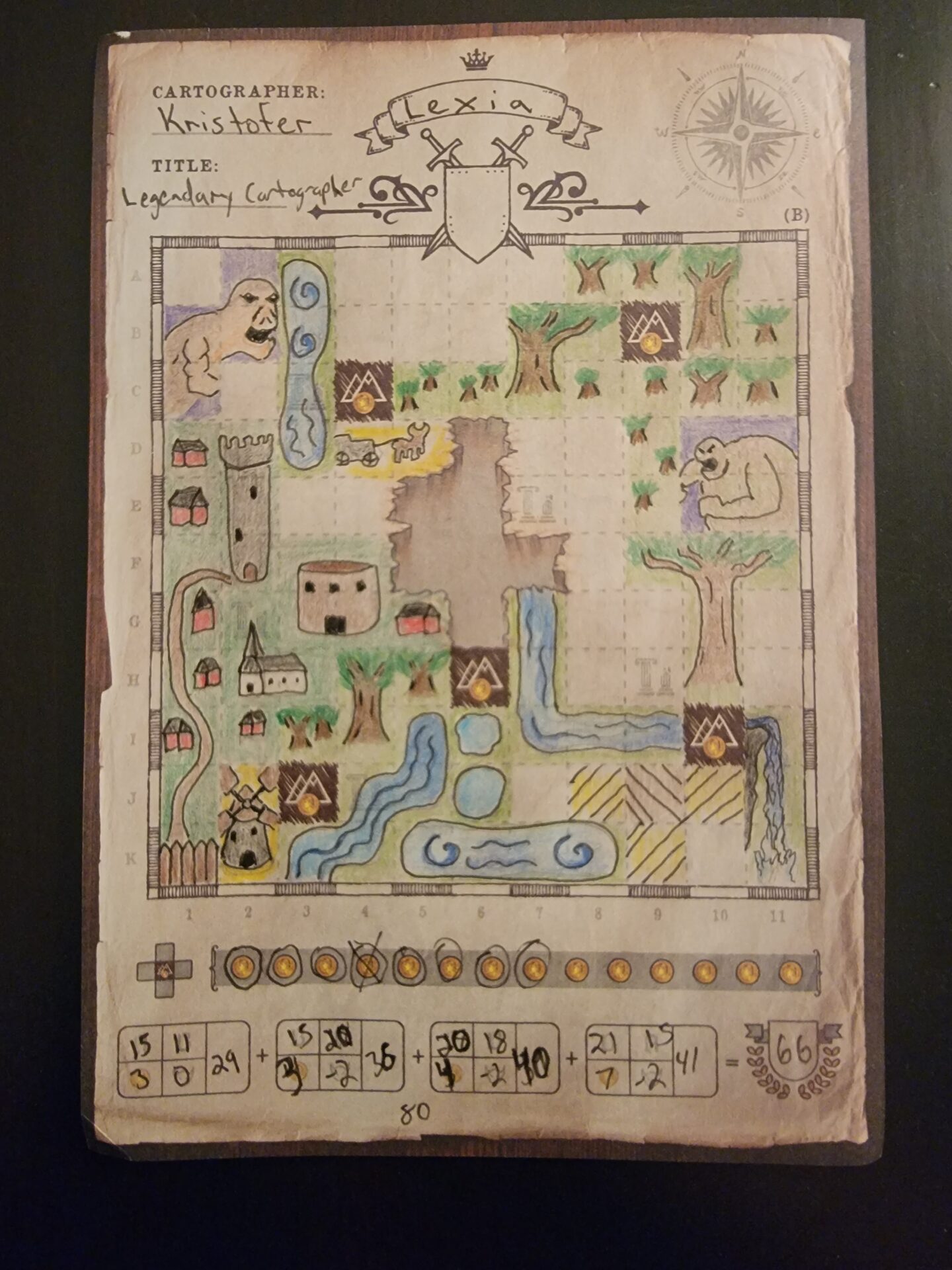
Obviously, when playing games with a lack of components there is typically a lack of setup time and Cartographers is no different. Each player needs one of the Map sheets and all players need to decide which side they are playing with (as the maps are double sided with a different layout printed on each side.) The cards then need to be separated into their different stacks. First, the Season Cards should be placed in a stack in the following order: Spring, Summer, Fall, and Winter. The aforementioned Scoring Cards can be separated into their four different categories, based on the card backs, and then one from each category is to be drawn with the rest being put back in the box. Players will take the four cards labeled A through D, and randomly place one Scoring Card under each of these, therefore declaring which edict is which.
Lastly, there are four Ambush Cards that have the same back as the Explore Cards. These four are removed, shuffled, and placed in their own face-down stack. The top Ambush Card is taken and shuffled into the rest of the Explore Cards, thus forming the Explore Deck. All players grab a writing utensil are the game is ready to be played!
Each round takes place over three phases. In the Explore Phase, a player will flip over the top card in the Explore Deck so that all players can see it. If it is a card depicting any type of Ruins, another Explore Card is flipped. As long as the next card is not also a Ruins card, players can move on to the Draw Phase. This phase is where most of the action takes place. On the Explore Cards, there is typically either a.) a choice of Terrain Types and a single shape or b.) a single Terrain Type and a choice of shapes. All players make their choice of which to draw and then draw the shape and terrain onto their Map Pad. Players can draw these almost anywhere, as long as they aren’t drawing on top of the border, on top of a Mountain Space or on top of an already drawn shape. Lastly, a Check Phase happens where the values on the top left of the revealed Explore Cards is summed together and checked against the value on the current Season card. If the values match or if they are higher than the Season card, the season is over and points are scored. If not, the next Explore Card is drawn and the phases start over.
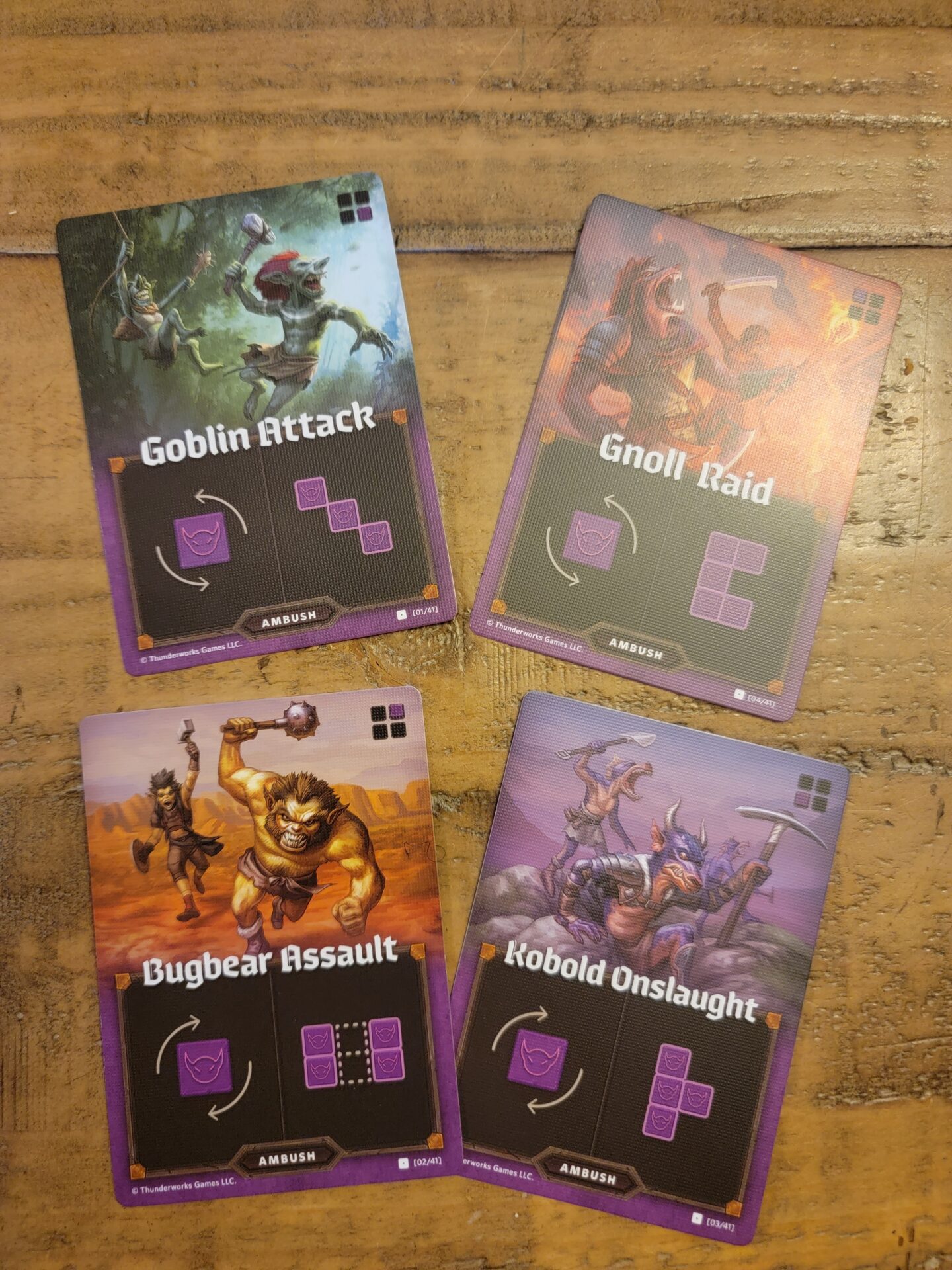
Sounds easy enough but there are a few things that will help players steer towards their objectives. First, each season allows players to only score two of the four Edicts (or Scoring Cards.) These cards layout the goals for your map (such as gaining points for all Forest spaces that are fully surrounded) and will help players determine when and where to draw the shapes. I really love how the seasons change the scoring parameters as what you are focusing on with your map might only be helpful for the first two seasons and then that terrain might not be scored again so players need to make a change in what is important. Even with this being said, players should have all scoring parameters in mind so that they can be building to scoring massive points when the Winter season arrives.
Second, players can be awarded Gold Coins (which they circle on their pad) for choosing certain shapes, typically the smaller ones, or if they completely surround a Mountain space. These Gold Coins award extra points at the end of each season. Lastly, there is a clever bit of player interaction through in for good measure. During the setup, I mentioned four Ambush cards and how one is shuffled into the Explore Deck at the beginning of the first season. These Ambush cards depict a purple shape as well as a monster and a circular set of arrows pointing in a certain direction. When this card is revealed, all players pass their map to their opponent based on the arrow direction, and then players will draw the monster shape anywhere on their opponent’s map. At the end of each season, all empty spaces adjacent to any monster spaces, end up creating negative points that go against the player’s total score. The shapes aren’t big enough where they will demolish a player’s score but I do like that this adds a fun level of interaction where an opponent can throw a wrench into another player’s long-term plans. I also like that once the Ambush card is drawn, it is discarded from the game and a new one is only added at the beginning of the next season. In this way, if you do not draw an Ambush card during a season, you will have two in the deck going into the next season but the discarding of the used ones makes it so you’ll never have a deck full of Ambush cards.
After all four seasons have been scored, players add them up and the total score wins. Multiplayer takes around 30 minutes and is quick and easy enough for even a novice board gamer to pick up and play quickly.
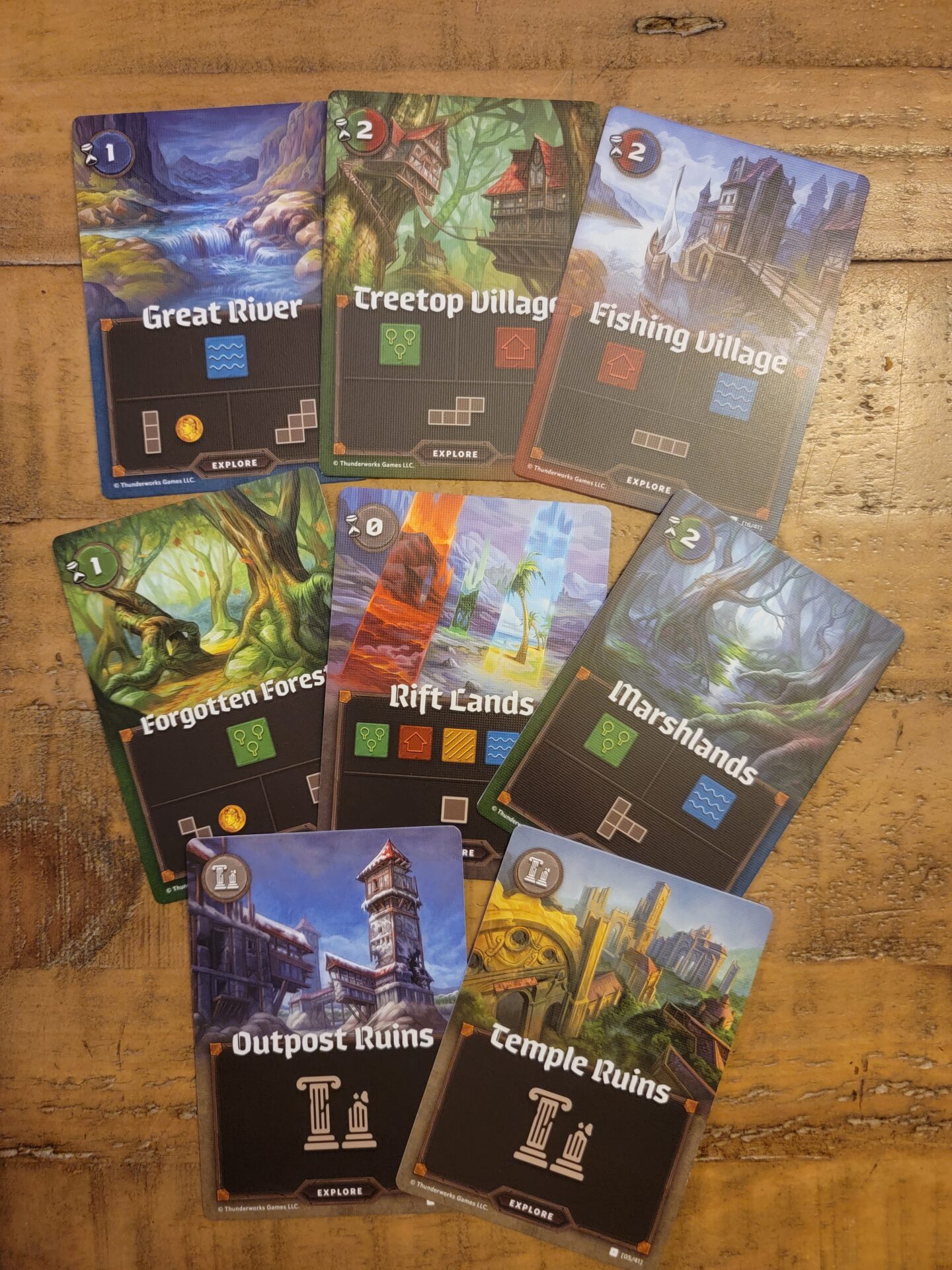
Solo Mode Thoughts
One of the most intriguing reasons for picking up Cartographers was the ability to play the game in solitaire mode. Gameplay is almost identical to the multiplayer mode, except for how the player handles the Ambush cards and final scoring. For the Ambush Cards, the player will look in the top right hand corner of the card which will depict one of the four corners of the map. The player will start in this corner and then move in a circular motion (based on the arrows on the Ambush card) around the border of the map, attempting to find the first place they can draw the monster shape exactly as it is depicted on the card. If there are no legitimate spaces, then the player moves in one row and makes another pass. This continues until either a.) the player can draw the shape or b.) there are no legitimate placement options and the player can then just discard the Ambush card. While this is a clever mechanism to use the Ambush cards in solo mode, practically speaking, the results are varied. Sometimes, the first valid spot you can place it in actually helps you cover up needed spaces and you might not even have to try hard to fill the spaces adjacent to the newly drawn Ambush shape.
The second big difference is that each Scoring Card has a point value in the bottom right hand corner. At the end of the solo game, these points are all summed together and then subtracted from the player’s final score. There is then a “rating system” of point brackets that the player compares to, in order to see which title they are awarded. I like that this helps to balance out the game but when it comes to Scoring Cards, what I would have really liked to see were some scenarios. The rulebook could have had certain combinations of Scoring Cards and a specific point total that needed to be met. If you’ve played games such as Cascadia or Verdant, you’ll know how much fun this can add to the solo gameplay experience.
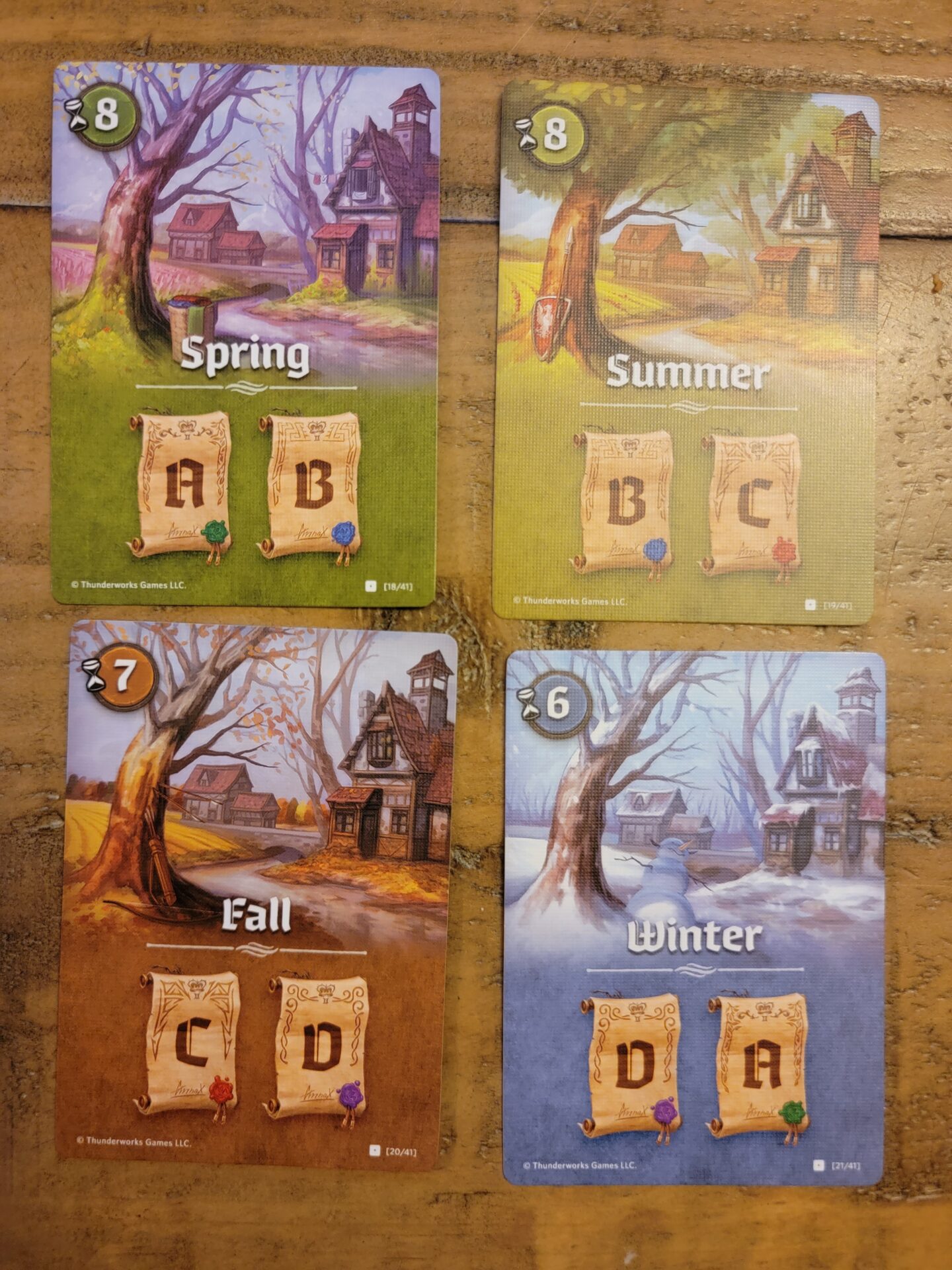
Conclusion
I’m really happy that I gave Cartographers a chance and did not write it off as I have so many other “x-and-write” games. The multiplayer experience is fast, fun, and includes just enough player interaction without resorting to multiple “gotcha” moments. The solo game doesn’t quite live up to the multiplayer game, but I do know there are plenty of mini-expansions and extra map packs so some of these might alleviate my worries about solo replayability. On top of all this, if you like to draw and get creative while playing, Cartographers gives players a wide-open canvas to create some really pleasant looking maps to show off during your next board gaming session.
Rating
Ratings are based on 5 main criteria: rulebook, setup, components, art & graphic design, and gameplay. The first 4 criteria are rated 1 to 5 and the gameplay is rated 1 to 10. These scores culminate in an “overall satisfaction” score that is rated from 1 to 10. If the reviewed game has both a solo and multiplayer mode, I have assigned scores separately to give context to which mode we enjoy more.
Links
As an Amazon Associate I earn from qualifying purchases.
Amazon: Terraforming Mars – Ares Expedition board game

